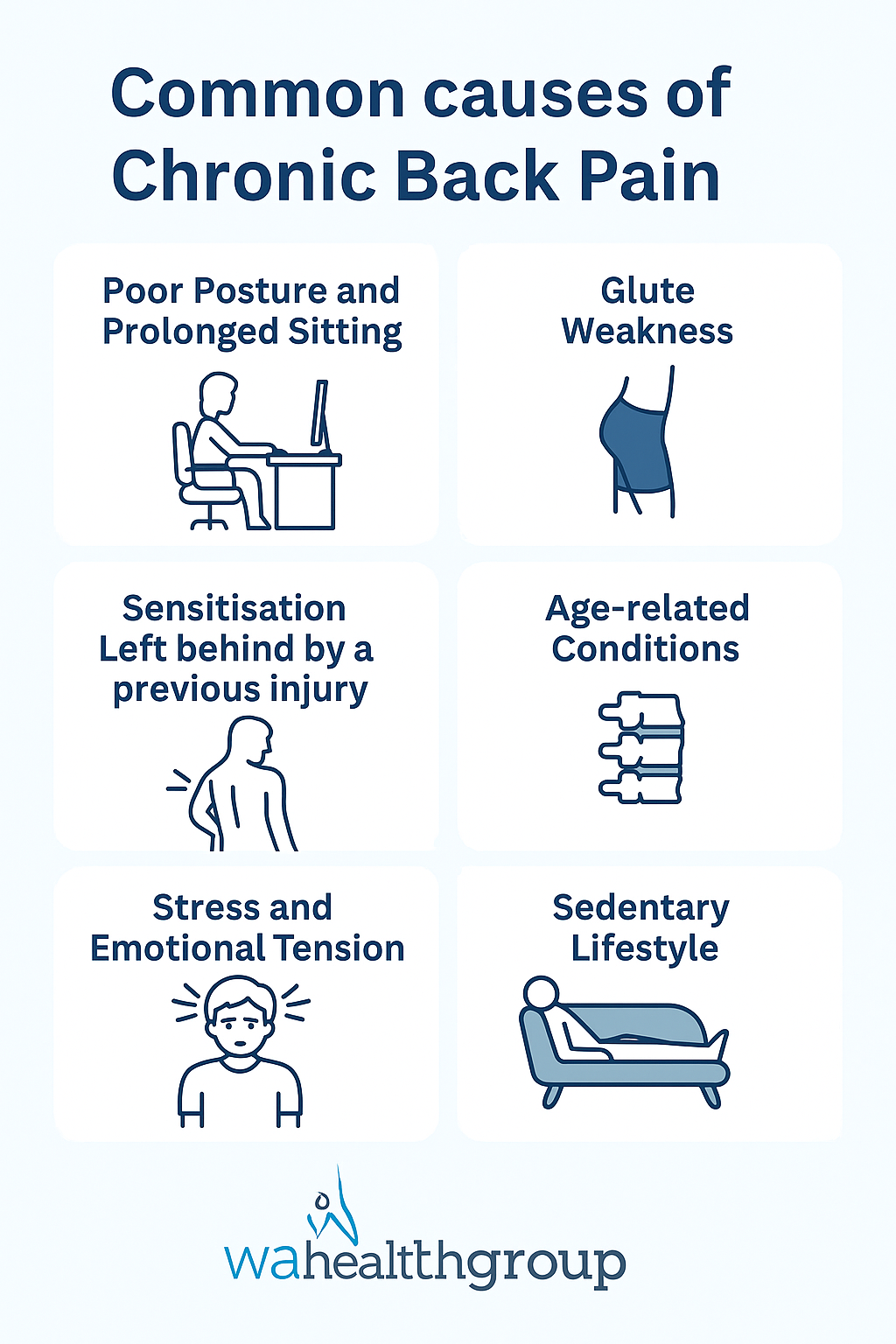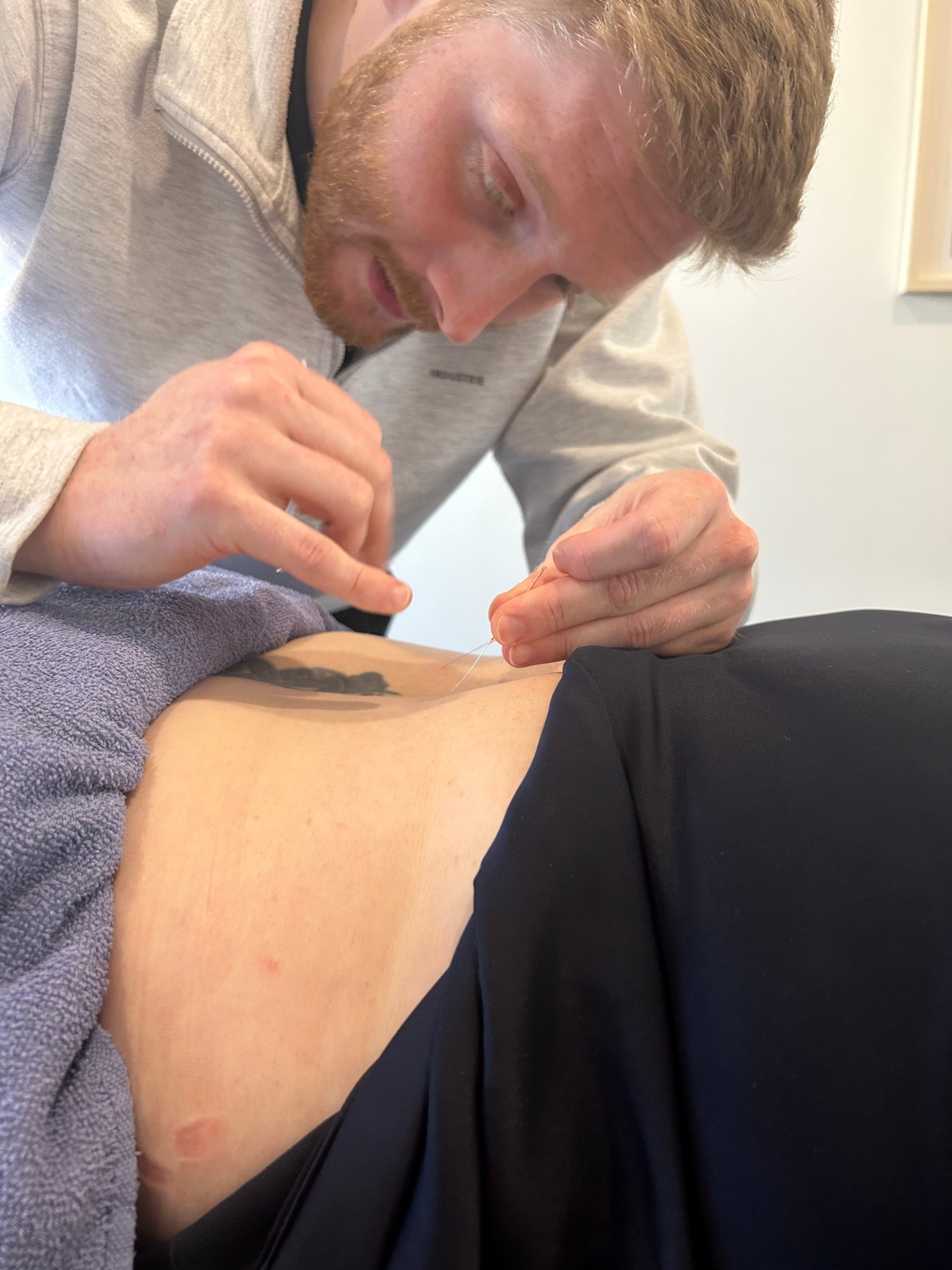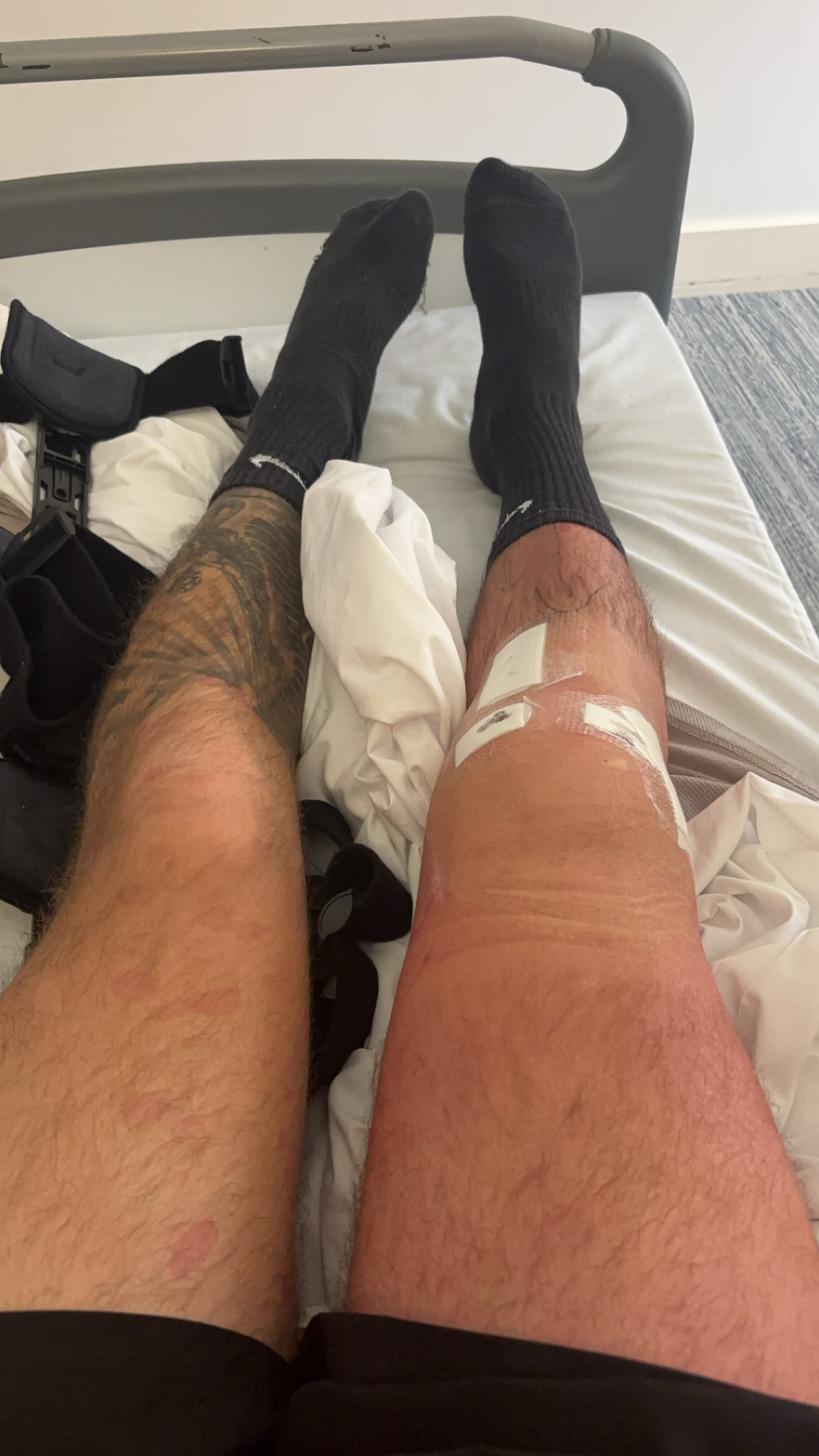Lower back pain can be more than just an occasional ache—it can disrupt your daily life, limit your mobility, and affect your overall well-being. In this blog, Samantha Clark, Senior Physiotherapist at Apex Physiotherapy, explores the most common causes of lumbar pain and how physiotherapy can offer long-term relief. From manual therapy and clinical Pilates to tailored exercise plans and postural education, discover how early intervention and expert guidance can help you move freely and confidently again.
Introduction
Living with chronic back pain can be physically exhausting and emotionally draining. It affects how you move, work, sleep and ultimately, how you live your life. While painkillers and short-term fixes might offer temporary relief, physiotherapy provides a long-term, evidence-based solution that addresses the root of the problem, not just the symptoms.
In this blog, we’ll explore:
- What is chronic back pain?
- What are the common causes of chronic back pain?
- Why choose physiotherapy for chronic back pain?
- How does physiotherapy help chronic back pain?
- What about other approaches?
- Our physiotherapy techniques for back pain relief
- What to expect in a physiotherapy assessment?
- 6 proven habits to support your recovery from chronic back pain
- Get help with chronic back pain
What is chronic back pain?
Chronic back pain is defined as pain that persists for 12 weeks or longer, even after an initial injury or underlying cause has healed. Unlike acute pain, which serves as a warning sign, chronic pain can linger and become more complex, often involving changes in how the brain and nervous system process pain signals.
What are the common causes of chronic back pain?

Chronic back pain doesn’t usually have one single cause. It often develops over time due to a mix of lifestyle factors, past injuries, and physical habits. Understanding what’s driving your pain is the first step toward long-lasting relief.
Here are some of the most common causes:
- Poor posture and prolonged sitting
Spending long hours hunched over a desk, laptop, or phone can place excessive strain on your spine and surrounding muscles—especially if your workstation isn’t set up ergonomically.
- Glute weakness and muscle imbalances
When your glute muscles aren’t doing their job properly, other areas (like your lower back) overcompensate. This imbalance leads to tension, poor movement mechanics, and ongoing pain.
- Sensitisation left behind by a previous injury
Even if your initial injury was years ago, your back may remain sensitised. Pain signals are possibly being sent to your brain despite the injury having healed a long time ago.
- Age-related “degenerative” conditions
Issues like osteoarthritis, degenerative disc disease, or spinal stenosis can lead to chronic inflammation and stiffness in the spine.
- Stress and emotional tension
Chronic stress doesn’t just live in your head—it often shows up in your body. Many people carry tension in their back and shoulders, which can contribute to persistent pain over time.
- Sedentary lifestyle and lack of movement
When we don’t move enough, our muscles weaken, joints stiffen, and the nervous system becomes more sensitive to pain signals. Sitting too much without regular breaks is a major risk factor.
Because chronic pain usually stems from a combination of physical, emotional, and lifestyle factors, it requires a personalised, whole-body treatment approach, exactly what physiotherapy is designed to deliver.
Why choose physiotherapy for chronic back pain?
Physiotherapy goes beyond passive treatment. It empowers you with tools, strategies, and movements that help you take control of your pain and improve your quality of life.
Here’s why physiotherapy is a smart, sustainable choice:
- Addresses the root cause, not just the symptoms
- Improves mobility, strength, and function
- Reduces reliance on pain medication
- Helps prevent future flare-ups
- Boosts confidence and body awareness
- Offers personalised care tailored to your lifestyle and goals
Explore our physiotherapy services in Bicton
How does physiotherapy help chronic back pain?

Physiotherapy is one of the most effective long-term approaches for managing chronic back pain. Rather than masking symptoms, it helps address the underlying causes, restore functional movement, and improve your confidence in day-to-day activities. Your treatment plan is tailored to your needs and may include a combination of the following proven strategies:
Manual Therapy
Your physiotherapist may use hands-on techniques to reduce pain and restore mobility. This can include:
- Soft tissue massage to release muscle tension
- Joint mobilisation to improve spinal movement
- Myofascial release techniques to reduce stiffness
Massage therapy is recommended in both acute and chronic stages of back pain and can help relieve discomfort, especially when paired with movement-based treatments.
Exercise Therapy
Targeted exercise is at the core of physiotherapy for chronic low back pain. While strengthening and core stability exercises produce modest improvements in pain and function, they remain essential for long-term outcomes. Your plan may include:
- Core stability training
- Glute and hip strengthening
- Thoracic and lumbar mobility exercises
- Functional movement retraining (lifting, squatting, bending)
- Stretching to improve flexibility in the hamstrings, quads, hip flexors, and piriformis
Though not every study shows large clinical effects, consistency with tailored exercises supports recovery and prevents flare-ups.
Postural & Movement Retraining
Many people with chronic pain develop poor movement patterns due to fear of triggering discomfort. Physiotherapy helps you:
- Rebuild confidence in everyday movements
- Learn safe lifting, walking, and sitting mechanics
- Correct faulty posture that may be stressing your spine
- Prevent compensatory patterns that lead to other injuries
Education & Pain Management
Pain education is a powerful tool in chronic pain recovery. Techniques like Pain Neuroscience Education (PNE) help you understand how pain works in the brain and body, reduce fear of movement, and increase your tolerance during activity. You'll also receive guidance on:
- How to pace yourself and manage flare-ups
- Activity modification without full rest
- Understanding your pain triggers
Cognitive Behavioural Strategies
For patients who have had chronic back pain for a long time, especially after full conservative treatment, Cognitive Behavioural Therapy (CBT) can support recovery by addressing the psychological component of pain. CBT may help you:
- Reframe negative pain beliefs
- Set realistic goals
- Improve mood and reduce disability
Stress, Sleep & Lifestyle Coaching
Stress, anxiety, poor sleep, and inactivity can all worsen chronic pain. Your physiotherapist may support you with:
- Breathing and relaxation techniques
- Sleep posture and routine advice
- Ergonomic adjustments at work or home
- Gentle movement routines to replace prolonged sitting
What about other approaches?
In addition to traditional physiotherapy, some people benefit from:
- McKenzie Method: A structured exercise program that shows comparable results to other therapies, with stronger short-term recovery perception
- Yoga: A promising adjunct that improves flexibility, pain, and function (though more research is needed)
- Pilates: Can offer relief, particularly in female patients, but evidence on long-term benefits remains limited
- Manipulative therapy: Offers slightly better outcomes than sham treatment, but not superior to standard physiotherapy care
However, modalities like ultrasound, laser therapy, TENS, or shortwave diathermy are not supported by evidence for chronic back pain and are generally not recommended.
In conclusion, physiotherapy offers a comprehensive, multidisciplinary approach to chronic back pain, focusing not just on the spine, but on the whole person. With the right plan and support, you can move better, feel stronger, and live with more confidence and less pain.
Our physiotherapy techniques for back pain relief

When it comes to treating back pain, me and my team use a combination of proven physiotherapy techniques tailored to your specific needs. Our goal is to not only reduce your pain but also restore your movement and help you feel more confident in your body again.
Here are some of the techniques we commonly use:
- Joint mobilisation and manipulation
We apply gentle, controlled movements to your spinal joints to reduce stiffness, improve alignment, and restore natural motion.
- Deep tissue massage and trigger point therapy
These hands-on techniques help release muscle tension, improve blood flow, and reduce discomfort in overworked or tight areas.
- Dry needling
We use fine, sterile needles to target trigger points—relieving muscle spasms, easing tightness, and helping with pain control.
- Movement retraining and corrective exercise
We work closely with you to rebuild strength, improve posture, and restore proper movement patterns that protect your spine in daily life.
- Stretching and mobility work
Carefully chosen stretches increase flexibility in key areas like your hamstrings, hips, and lower back—helping reduce strain and improve movement.
- Bracing or taping (when needed)
For extra support during recovery, we may use taping or bracing to help stabilise joints and guide movement.
What to expect in a physiotherapy assessment?
We start by helping you move better and feel less pain. Then, we focus on long-term strategies to keep your back strong and prevent future flare-ups. Our goal is lasting relief, not just quick fixes. Your first appointment is all about understanding your pain. We will:
- Ask detailed questions about your symptoms, health history, and lifestyle
- Assess your posture, movement patterns, strength, and flexibility
- Identify any muscular imbalances, mobility restrictions, or compensation habits
- Set clear goals with you—whether it’s walking pain-free, returning to sport, or lifting your kids comfortably
Not sure where to begin? Let’s figure it out together.
Book a 15-minute complimentary health assessment with one of our physiotherapists and discover how we can support your goals and wellbeing.
Recovering from chronic back pain takes time, consistency, and a proactive mindset. While physiotherapy lays the foundation, your daily habits are key to lasting results. Here are six proven ways to support your recovery and reduce the risk of flare-ups:
Remember, recovery is a process, and small daily actions can lead to big long-term changes.
Chronic back pain may be common, but it’s not something you have to accept as “normal.” With expert physiotherapy and the right support, you can break the cycle of pain, restore your function, and start living more freely again.
Book an appointment with our physiotherapy team today—we’re here to guide your recovery, every step of the way.












